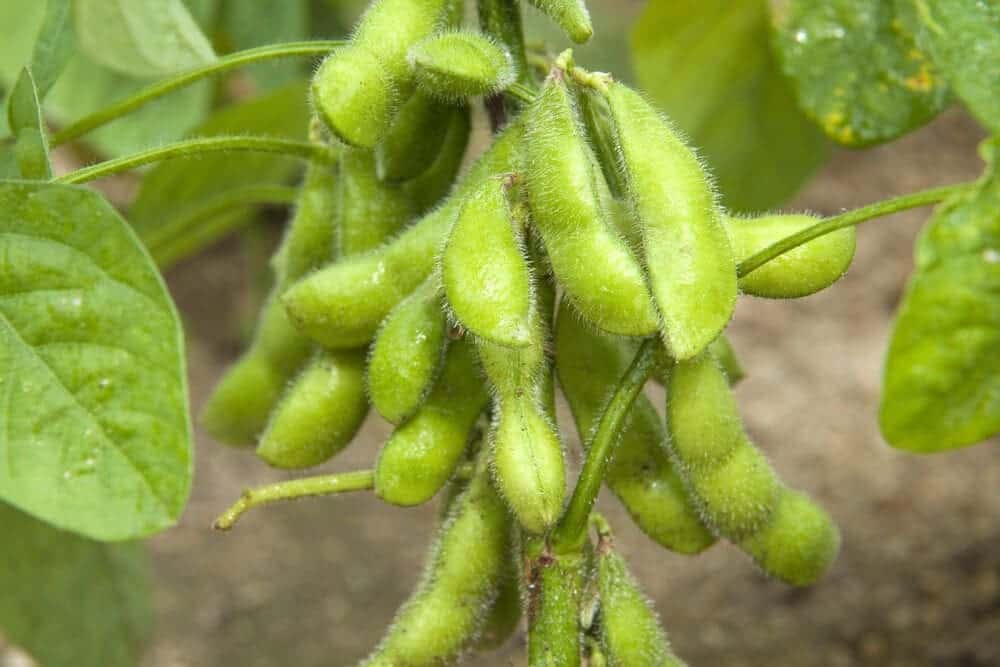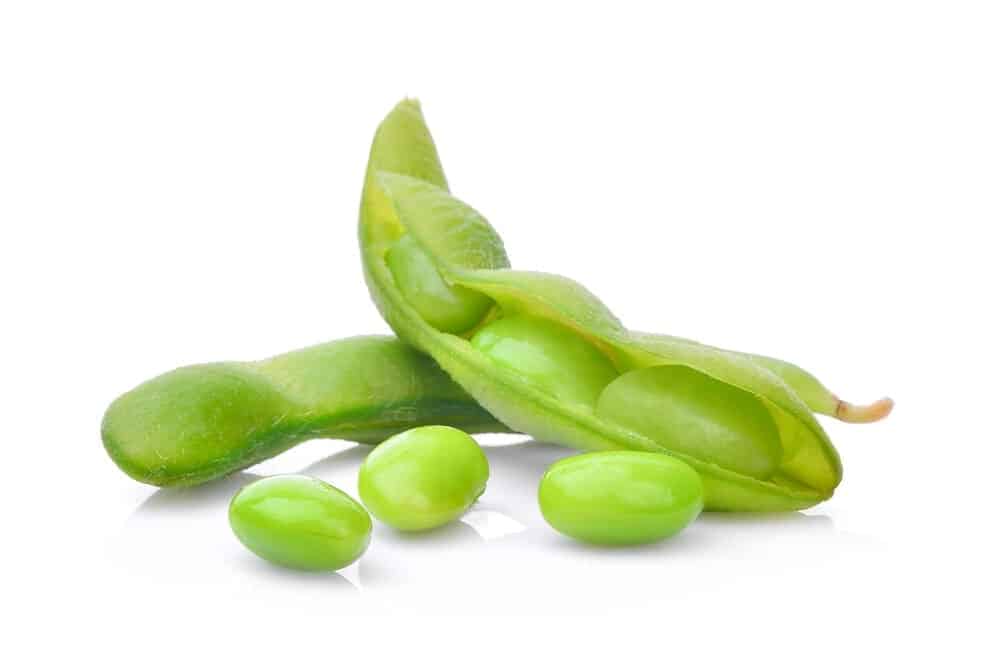The Edamame is an immature soybean pod that is relatively new to North American gardeners.
This is a complete source of protein with all nine essential amino acids. It is an Asian vegetable that means beans on branches.
They taste like a cross between a lima bean and pea. Out of each pod, you will get two or three beans.
Edamame Care & Growing Guide
1. Light Requirement
The Edamame will need to be grown in full sun but they can tolerate partial shade.
2. Water
During the growing season, you need to make sure that you water the Edamame regularly. This is especially true after the pods and flowers appear. After they are mature, you will only need to water them when the top inch of soil is dry. You can keep them strong by regularly feeding them with water-soluble plant food.
3. Climate
USDA Hardiness Zone 3-9
4. Soil
The soil needs to drain well and should be compost-enriched. It needs to be loamy and neutral to slightly acidic. It should have a pH of 6.0-7.5. When your plants reach six inches tall, you should add a layer of mulch made from leaves that have been finely ground. Before you plant the seeds, you should plow the ground first. This will help to ensure aeration.
5. Temperature
The temperature of the soil needs to be 55-65 degrees Fahrenheit in the spring when you can start planting them. During the summer for the seeds to germinate, the temperature of the soil needs to remain 60-90 degrees Fahrenheit.

6. Repotting
This is not a type of plant that you would normally grow inside so there is no reason or need to repot them.
7. Speed of Growth
They require a long growing season; 75-110 days to mature and the growing season lasts from spring to summer during which time the pods can be harvested.
8. Height and Spread
They can grow from one to three feet tall. When they get two to three feet in height you should stake each plant for support so they do not droop over.
9. Flowers
They have white flowers before the green pods appear.
10. Trimming
There is no need to trim this type of plant

Is Edamame Poisonous?
Edamame is not poisonous to humans or animals as the beans are edible.
Can Edamame grow in Water?
No, they need to grow in soil.
How to get Edamame to Flower?
Although they do not exactly bloom for flowers, the seeds are edible plus they can be dried for other products.
Growing and Harvesting Edamame
Before planting Edamame seeds, make sure that you do not soak the seeds first but you should lightly spray them with water. Once they are sprayed, you should sprinkle them with soybean inoculants powder. This is a type of beneficial bacteria that helps to transfer the nitrogen in the air to the roots of the plant as it grows. When the seedlings are four inches tall, you will need to thin them to six inches apart. To help maintain moisture and control the weeds, apply mulch around the plants.
When planting Edamame, space the seeds 12-18 inches apart, two feet between rows, and one to two inches deep. You should use a square-foot gardening layout. So that all of the Edamame does not mature at the same time, you should plant another batch of Edamame seeds ten days after the first planting. You can continue planting until the beginning of July.
All the Edamame beans on the plant will mature at the same time so you will need to harvest all of them. You will have three to seven days to harvest them before they are no longer tasty to eat. The pods are ready to harvest when they are plump, bright green, and two to three inches long. Cut or snap off the pods so they do not tear the plant. Store the pods in the refrigerator. You can also dry out the pods so you can plant them next year. If you have too many to eat, you can freeze them while in the pods.
More like this: Epiphyllum Plant Care & Growing Guide
Common Plant Diseases
Edamame is prone to a variety of diseases, including:
- Mexican beetle—they eat at the tissue from the underside of the leaves. You can pick off the beetles and larvae to destroy them or use an approved insecticide or pesticide.
- Rabbits—one way to keep them from eating the plants is to sprinkle dried sulfur around the plants or plant onions around them as they do not like the smell of either.
- Whiteflies—they suck the juices from the plants, causing the leaves to turn yellow or pale, stunted growth, and wilting leaves. You can get rid of them by spraying them with water from your hose to wash them off or spray with a soapy mixture.
- Powdery mildew—the leaves look like they have been dusted with flour. To get rid of them, you need to remove the infected parts and destroy them or spray with fungicides.
- Yellowing leaves—they are not getting enough nitrogen so you will need to use some nitrogen fertilizer.
Keep reading:
- Dill – Planting, Growing, and Harvesting
- Asparagus – Growing & Harvesting Guide
- How Often to Water Fiddle Leaf Fig? [COMPLETE GUIDE]
Conclusion
- The botanical name for Edamame is Glycine max
- When they harden and dry, they can be used to make tofu and soy milk.
- You can steam them in water, squeeze the bean out of the pod, and eat them.
- When you weed your Edamame, make sure that you do not disturb the roots
- Edamame beans can be used in stir-fry dishes or just steamed and salted.
- The Edamame plant is an attraction for butterflies.
- The pods appear in bunches on bushy, branched plants.
- Fertilize your Edamame plants with a fertilizer that is rich in phosphorous and potassium.
- They generally bloom in June and July.
- To freeze Edamame pods, blanch in salty boiling water, drain them and put them in freezer bags. To cook, put the frozen pods in boiling water for 15 minutes. Once done, pop the bean out of the pod and they are ready to eat.
Victoria is the owner and main author of hobby plants. She loves spending her free time in her garden planting and taking care of her plants. Victoria hopes you enjoy the content here!
![Mother Of Thousands Plant [Complete Plant Care Guide] Mother Of Thousands Plant [Complete Plant Care Guide]](https://www.hobbyplants.com/wp-content/uploads/2022/07/mother-of-thousands-plant-300x158.jpg)
![Majesty Palm Plant Care: [Complete Beginner's Guide] Majesty Palm Plant Care: [Complete Beginner's Guide]](https://www.hobbyplants.com/wp-content/uploads/2022/08/majesty-palm-care-300x158.jpg)
![Exotic Angel Plant Care: [Complete Beginner's Guide] Exotic Angel Plant Care: [Complete Beginner's Guide]](https://www.hobbyplants.com/wp-content/uploads/2022/08/exotic-angel-plant-care-300x158.jpg)
![Snow White Waffle Plant: [Complete Care Guide] Snow White Waffle Plant: [Complete Care Guide]](https://www.hobbyplants.com/wp-content/uploads/2022/08/snow-white-waffle-plant-300x158.jpg)
![Waffle Plant Care: [Complete Beginner's Guide] Waffle Plant Care: [Complete Beginner's Guide]](https://www.hobbyplants.com/wp-content/uploads/2022/08/waffle-plant-300x158.jpg)
![Bird Of Paradise Plant Care: [Complete Beginner's Guide] Bird Of Paradise Plant Care: [Complete Beginner's Guide]](https://www.hobbyplants.com/wp-content/uploads/2022/08/bird-of-paradise-plant-300x158.jpg)
![Purple Passion Plant Care: [Complete Beginner's Guide] Purple Passion Plant Care: [Complete Beginner's Guide]](https://www.hobbyplants.com/wp-content/uploads/2022/08/purple-passion-plant-care-300x158.jpg)
![China Doll Plant Care: [Complete Beginner's Guide] China Doll Plant Care: [Complete Beginner's Guide]](https://www.hobbyplants.com/wp-content/uploads/2022/09/china-doll-plant-care-300x158.jpg)
![Polka Dot Plant Care: [Complete Beginner's Guide] Polka Dot Plant Care: [Complete Beginner's Guide]](https://www.hobbyplants.com/wp-content/uploads/2022/09/polka-dot-plant-300x158.jpg)
![Mona Lisa Lipstick Plant Care: [Complete Beginner's Guide] Mona Lisa Lipstick Plant Care: [Complete Beginner's Guide]](https://www.hobbyplants.com/wp-content/uploads/2022/09/lipstick-plant-mona-lisa-300x158.jpg)
![Yucca Cane Plant Care: [Complete Beginner's Guide] Yucca Cane Plant Care: [Complete Beginner's Guide]](https://www.hobbyplants.com/wp-content/uploads/2022/09/yucca-cane-plant-care-300x158.jpg)
![Bush On Fire Croton Plant Care: [Complete Beginner's Guide] Bush On Fire Croton Plant Care: [Complete Beginner's Guide]](https://www.hobbyplants.com/wp-content/uploads/2022/09/bush-on-fire-croton-300x158.jpg)